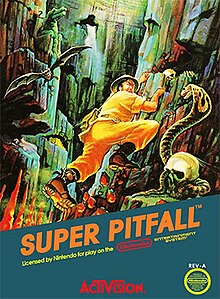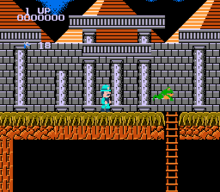Super Pitfall
| Super Pitfall | |
|---|---|
 NES box art | |
| Developer(s) | Micronics (NES) |
| Publisher(s) | |
| Programmer(s) | Color Computer 3 Steve Bjork PC-88 Makoto Ichinoseki |
| Platform(s) | |
| Release | NES |
| Genre(s) | Platform[1] |
| Mode(s) | Single-player, multiplayer[2] |
Super Pitfall (スーパーピットフォール, Sūpā Pittofōru) is a 1986 side-scrolling non-linear platform game for the Nintendo Entertainment System (NES). Despite the title screen stating that it was reprogrammed by Pony Inc., the development of the NES version was handled by Micronics, a Japanese developer who mostly ported arcade games to the NES.
Super Pitfall was the first game that Activision published as a third-party developer for the NES. Following the original release of the game, ports were made in Japan by Makoto Ichinoseki for the PC-8800 series liner of computers and by Steve Bjork for the Color Computer 3. The game initially received positive reviews from VideoGames & Computer Entertainment and Computer Entertainer while Bill Kunkel wrote in Computer Gaming World that the game did not control well and did not stand out well in a market of Super Mario Bros. clones. Retrospective reviews of the NES game from game critic Brett Weiss and Stuart Hunt of Retro Gamer found the game a step down from the previous Pitfall games on the Atari 2600, with both faulting low quality graphics and game design.
Activision initially was going distribute Sunsoft's Atlantis no Nazo in the United States in a rebranded form as a sequel to Super Pitfall on the Super Nintendo Entertainment System. This release did not happen.
Gameplay
[edit]
The game features Pitfall Harry as the player character.[3] Equipped with a gun, he seeks to recover the Raj diamond from a vast subterranean dwelling in the Andes Mountains and rescue his niece Rhonda and cat friend Quickclaw the Lion who are trapped deep in the caverns.[3] The goal is to move Harry through a nonlinear cave maze finding the two trapped friends and collect the Raj diamond and return to the starting point.[1][4] While playing, Harry will find that Rhonda has turned to stone and Quickclaw is trapped and both require items to be freed. To return home, Harry must collect a photograph of the Underground Kingdom for a clue on how to return entrance.[4] Harry begins with three lives and on touching an enemy or a hazard he loses one. Lives can be earned from collecting 50,000 points, and then 80,000 the next.[5] Points are collecting by shooting and defeating enemies and collecting gold bars and other items.[6]
Harry is maneuvered with the directional pad to move left and right and can climb and swim upwards with the up arrow. He can jump and fire his gun with the a and b buttons respectively.[7] Harry can collect items shaped like playing card suits to open rock doors as well as spare pistols and items that make him invulnerable to enemies. Items in the game are invisible and can only be grabbed at certain moments while jumping.[8]
Development
[edit]Super Pitfall was developed by the Japanese company Micronics.[9] Micronics predominantly did work in outsourcing tasks and generally made Nintendo Entertainment System (NES) versions of popular arcade titles such as Ikari Warriors and 1942.[10] Stuart Hunt of Retro Gamer described the game as a loose port of the Atari 2600 game Pitfall II: Lost Caverns.[9]
In Japan, the game was released for the PC-8801MKIISR model in the PC-8800 series of home computers. It was designed by Makoto Ichinoseki.[11] Steve and Monique Bjork contributed to the Color Computer 3 (CoCo 3) port of Super Pitfall. Steven had written the code for it and over 20 Tandy and Color Computer programs, while Monique contributed to the graphics in the game.[12][13] The CoCo 3 version, three difficulty options are made available, in expert mode: the items Harry seeks are invisible while in explorer mode Harry has unlimited lives and treasures remain visible.[13]
Release
[edit]Super Pitfall was released in Japan for the Family Computer on September 5, 1986.[14] Super Pitfall was the first game published by Activision that was released on the NES.[15] It was released in the United States for the NES in November 1987.[16] It was later released for the Color Computer 3 and required 512K of memory to operate.[17][18]
Activision was going to release Sunsoft's Atlantis no Nazo rebranded as a sequel to Super Pitfall on the Super Nintendo Entertainment System. It never received a release in the United States.[19] A fan remake of Super Pitfall by Nesrocks was released in 2016. The new version of the game changing the visuals, redesigning levels and a new score.[20]
Reception
[edit]Bill Kunkel wrote in Computer Gaming World found the playing character's movement was slow and floaty and that its gameplay and visuals were too similar to that Super Mario Bros. (1985). Kunkel concluded that "there is nothing in the game itself to keep [NES users] awake."[21] A review in Computer Entertainer found the game gave players plenty to explore, specifically noting large amount of secret areas and hidden objects and recommended it to fans of the two previous Pitfall games on the Atari 2600.[22] VideoGames & Computer Entertainment gave the game a high grade of four for its action and lower points of two for its music and sound, declaring the game to be a "higher quality" form than its previous entries.[23] Tony Olive in The Rainbow reviewed the CoCo port, praising the graphics as arcade-quality, with smooth movement, and finding the game to be fun and challenging.[13]
From retrospective reviews, Stuart Hunt wrote in Retro Gamer that the game was derided by most fans of the Pitfall series. Hunt specifically noted poor collisions detection, flickering sprites and stiff animation and that a lot of the game play involved frustrating trial and error. Hunt also found that having a weapon in the game was useless as it passed over most enemies heads and that the sprite of the player looked too much like Mario in a safari hat.[9] Brett Weiss, in his book Classic Home Video Games, 1985-1988 (2009) found the game to have awful music and graphics and generic level design finding it far inferior to the previous Atari 2600 games.[24]
References
[edit]- ^ a b Marriott.
- ^ Metzger 1987, p. 2.
- ^ a b Metzger 1987, p. 1.
- ^ a b Metzger 1987, p. 4.
- ^ Metzger 1987, p. 6.
- ^ Metzger 1987, p. 8.
- ^ Metzger 1987, p. 2-3.
- ^ Metzger 1987, p. 5.
- ^ a b c Hunt 2012, p. 84.
- ^ Alpert 2010.
- ^ BASIC 1987.
- ^ Parker 1989, p. 75.
- ^ a b c Olive 1988, p. 132.
- ^ Family Computer Magazine 1986.
- ^ Computer Entertainer 1987.
- ^ Computer Entertainer 1987, p. 14.
- ^ 1989 Tandy Computer Catalog 1988, p. 45.
- ^ Goodman 1990, pp. 75–76.
- ^ Fielder 2003, p. 68.
- ^ Lopes 2016.
- ^ Kunkel 1988, pp. 44–45.
- ^ Computer Entertainer includes The Video Game Update 1988, p. 10.
- ^ VideoGames & Computer Entertainment 1988, p. 43.
- ^ Weiss 2009, p. 185.
Sources
[edit]- Alpert, Ron (July 24, 2010). "Retro Game of the Day! Tiger-Heli". Game Developer. Retrieved December 4, 2023.
- Fielder, Joe (April 2003). "Pitfall Harry". Electronic Gaming Monthly. No. 165. Ziff Davis Media. ISSN 1058-918X.
- Hunt, Stuart (2012). "The History of Pitfall!". Retro Gamer. No. 107. Imagine Publishing. ISSN 1742-3155.
- Goodman, Marty (March 1990). "Converting to CoCo". The Rainbow. Falsoft Inc. ISSN 0746-4797.
- Kunkel, Bill (August 1988). "Video Gaming World". Computer Gaming World. No. 50. Golden Empire Publications. pp. 44–45.
- Lopes, Gonçalo (September 9, 2016). "Super Pitfall Gets the Fan-Made 30th Anniversary Makeover it so Badly Needed". NintendoLife. Retrieved February 26, 2024.
- Marriott, Scott Alan. "Super Pitfall". Allgame. Archived from the original on November 15, 2014. Retrieved February 17, 2024.
- Metzger, Elizabeth (1987). Super Pitfall Player's Guide. Activision.
- Olive, Tony (December 1988). "Super Pitfall - Back in the Mines". The Rainbow. Vol. 7, no. 5. Falsoft Inc.
- Parker, Jeffrey S. (September 1989). "Seminars Educate, Enlighten, Entertain". The Rainbow. Falsoft, Inc.
- Weiss, Brett (2009). Classic Home Video Games, 1985-1988. McFarland and Company, Inc. ISBN 978-0-7864-6937-6.
- "Super Pitfall". BASIC (in Japanese). February 1987.
- "Pitfall Harry Returns". Computer Entertainer the Newsletter. Vol. 6, no. 6. September 1987. ISSN 0890-2143.
- "Availability Update". Computer Entertainer the Newsletter. Vol. 6, no. 9. December 1987a. ISSN 0890-2143.
- "Nintendo Software". Computer Entertainer includes The Video Game Update. Vol. 7, no. 2. May 1988. ISSN 0890-2143.
- "スーパーピットフォール". Family Computer Magazine (in Japanese). No. 18. Tokuma Shoten. August 15, 1986.
- "Color Computer Software". 1989 Tandy Computer Catalog. 1988. p. 45.
NEW! Super Pitfall. The Nintendo Classic comes to your Color Computer 3.
- "Super Pitfall". VideoGames & Computer Entertainment. December 1988.
